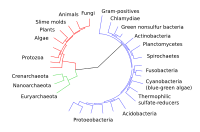系统发生学
演化與演化論 |
|
關鍵議題 |
進化論介紹 |
機制與過程 |
群体遗传学 · 遗传多样性 |
研究與歷史 |
證據 |
演化生物學領域与应用 |
社會生物學 |
生物學主題 |
系统发生学(希臘語:φυλογένεση,[φύλο] 错误:lang-xx:文本有斜体标记(帮助),现代希腊语:fílo - 种系,性别和γεννήση,现代希腊语:jénnissi - 新生,诞生。英语:Phylogenetics,又稱系統發育學,简称为譜系學)是指在地球历史发展过程中生物种系的发生和发展。
这个概念不单止用于动物种系的发生與发展,还会用在系统学各个层面的分类单元上面。它也会被用到某一特征的在生物发育过程中的进化这一方面。
系统发生学的研究是通过以下的手段实现的:
化石形态学和解剖学特征的比较和研究,- 现存生物的形态学,解剖学和生理学特征的比较,
- 生物,特别是现存生物的个体发生研究,
DNA分析,例如测序和分子系统发生学方法。
通过这些数据,人们就可以为生物建立一棵系统发生学树(演化树),其中描述了各个物种之间可能有的亲缘关系。
系统发生学研究的最大困难是,系统发生学的进化过程是不能被直接通过观察和实验被证实的。所以各个方面的证据都要被综合起来分析。由于对这些证据的侧重不同,会经常造成有多个不同的演化树版本,例如原口类动物的几个门究竟是归到蜕皮动物(来自遗传学方面的证据)还是触手动物(形态学方面的证据)。
特征分为同源和同功两种。
- 同源,例如同源器官或是同源的行为方式,会显示出相同的躯体基本构造,因为环境的不同而进化成不同的外形或功能。同源器官的外形和功能可以相差很大。一个很好的例子就是脊椎动物的前肢。它们可以成为足,翅膀(鸟, 翼龙,蝙蝠),鳍(鱼,企鹅,鱼龙,鲸),手(人类,猿和一些恐龙),挖掘工具(田鼠,裸滨鼠,袋鼹)。但其骨骼构造却是相似的。这些相似性只能用系统发生学的理论去解释。
同源特征证实了物种间的亲缘关系,是重构进化树的有力手段。同源现象在生物学中可以进一步分为直系同源(直系同源是指在不同物种中的某一基因來自同一祖先)和旁系同源(种系间的基因复制) 。
- 同功,例如同功器官外形的相似,功能的相同,但它们却是通过趋同演化独立发展出来开的。如墨鱼的眼睛和脊椎动物的眼睛,它们外形构造相似,功能都是感光。但透过显微镜可看到,它们的微细结构不一样。对个体发生的研究显示,它们是从不同胚层发育而来的。同功现象并不是亲缘关系的证据。
参考文献
外部链接
Beiträge zur Verhaltensphylogenese PDF
参见
- 生物学
- 演化
- 古生物学
- 生物分類法
- 支序分类学
| ||||||||||||||||||||||||||||||||||
|
